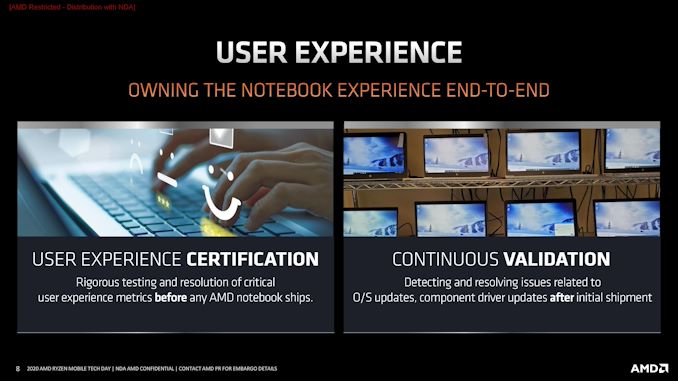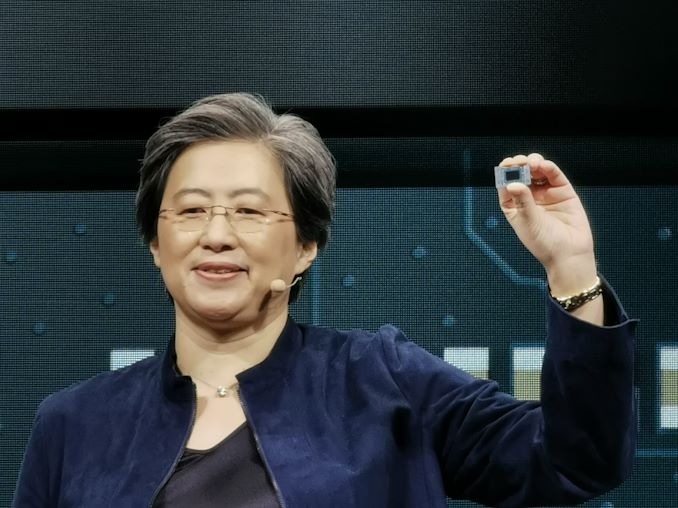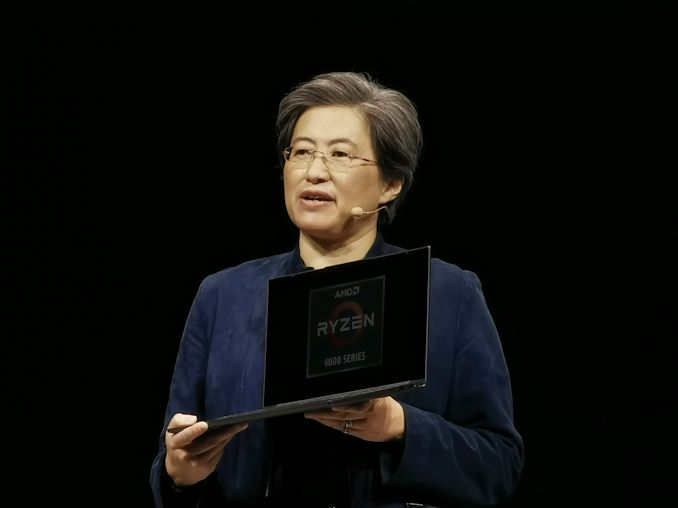AMD Details Renoir: The Ryzen Mobile 4000 Series 7nm APU Uncovered
by Dr. Ian Cutress on March 16, 2020 11:00 AM ESTThe Special HS Processors
As mentioned, at the top end of the new Ryzen Mobile 4000 list are the HS processors, offering almost exactly the same specification as the 45 W H-series processors, but at 35 W. AMD has marked these as special processors, not available to every OEM, because they fall under AMD’s new cooperative design and continuous validation programs.
In order to be able to use a HS processor, an OEM must work with AMD on the design. This is similar to what Intel does – ensure that the OEM partner gets the best from the hardware, and try and assist as to what design decisions the hardware was built for. Ultimately the product that comes out should be one that shows off the best of the hardware and gives the best user experience. On top of this, AMD has a list of ‘assured components’, validated to work against the new processors, and has created two continuous validation labs.
These labs, one in Austin and one in Shanghai, take the systems and pre-test all the new drivers and vendor software on them before they are released to the public. This is to ensure that the system is in no way compromised in performance, power, or thermals as a result of the update (to ensure that a company doesn’t completely mess with the power profile after it launches through a BIOS update or similar). AMD didn’t state how long its continuous validation program will run after the product is shipped, though I should think that at least 12-18 months should be plausible.
If the OEM does all this, and AMD agrees, then the product can use one of the HS processors.
(Note, the normal 45 W processors can be run in a 35 W mode, but just doing that doesn’t mean you can call it a HS. No doubt some third-tier OEM might try…)
The first HS-class system on the market will be the ASUS Zephyrus G14, and we learned in January that ASUS’s design has an exclusive for six months from launch. We’re expecting the G14 to hit the market in Q2, even with the current state of production, so we’ll see more HS models later in the year.
Conclusions
Ultimately today was the day that AMD was going to lift the embargo on Ryzen Mobile 4000 reviews, with the systems that AMD and its partners have provided. Due to the current ongoing issues around the world, those technical reviews of the systems will have to wait a few weeks while production is being ironed out. But for now we have a good grasp as to what AMD has pushing into the new processors coming out later this year.
Regular readers of AnandTech may remember back in 2016 I wrote a very long piece about AMD’s laptop strategy, where I tested five laptops from OEMs that were using AMD’s latest Carrizo APU at the time. The conclusions to that review were three fold: AMD was shooting itself in the foot by providing a platform that allowed its partners to be cheap; the OEM partners were being cheap by giving the hardware 13x7 screens, poor storage, poor trackpads and such because that’s all the customers seemed to want; and the customers were continually asking for cheaper systems, then getting frustrated with the poor user experience, ultimately blaming AMD rather than the OEM. It was a vicious cycle that required someone to break it.
Normally for these launches, a company will create a reference design for its partners to work with. AMD for years was creating these dull $500-$700 reference designs, which ultimately led to the paragraph above. We pled for generations for AMD to make a halo reference design, something ultraportable for $1500. For Renoir, given the reasonable performance uplift from the previous generation, the company worked with partners to create a range of high profile devices. I’ve covered a few of them in this article – the Lenovo Yoga Slim 7, the Dell G15 SE, and the ASUS Zephyrus G14 all attack different markets in very different ways, but all are examples of high-end products and design wins that AMD has needed in this market.
One of AMD’s big targets here is commercial. Despite the poor consumer performance of its older generations of laptops, the commercial laptop arm of AMD did reasonably well by comparison. AMD has announced its Ryzen Mobile 4000 Pro designs that afford admin control and sustainability over the lifetime of the product, and the key win here is that we’re seeing the processors in Lenovo’s Thinkpads, a key market.
The other big market is gaming. AMD can attack this on two fronts - the ultraportable market with the improved integrated graphics should get some good perfomrance, but also the more power hungry gaming market will get access to features like SmartShift to help balance the power between the APU and discrete GPU. AMD is also playing in the middle market here, with devices like the ASUS Zephyrus G14 with a HS processor and a Radeon RX5600M inside a 14-inch chassis, which AMD claims is the first 14-inch device with a H-class CPU and a discrete GPU inside. AMD's gaming team seem to be very happy with this design.
However, announcing systems is one thing. Deploying them is another. AMD has made a lot of claims about its Ryzen Mobile 4000 platform – performance, power consumption, and battery life. We’ve gone into detail into a lot of these, but we’re still missing one piece of the puzzle – the on-hand data. We’re hoping to get a system or two here in due course, and compare it against the competition.














95 Comments
View All Comments
Namisecond - Thursday, March 26, 2020 - link
Yeah, so is HBM over using system memory, but we're not going to see that on the 4000-series Ryzen either.realbabilu - Tuesday, March 17, 2020 - link
Will be apple interested too?Or apple will do things like licensing from amd zen2 platform and built own system?
Cliff34 - Tuesday, March 17, 2020 - link
My only wish is that Dell put this in their xps 15. I love how much mod and customization I can do with that model.yeeeeman - Tuesday, March 17, 2020 - link
Ian, can you make, on the review on one of these puppies a test like Andrei does on phones, that is compute the efficiency using SPEC? I want to see how Ice Lake stacks up.ballsystemlord - Tuesday, March 17, 2020 - link
Spelling and grammar errors:"...with within the right thermal envelope,..."
"but" not "with":
"...but within the right thermal envelope,..."
"If the CPU went too far down this stack, while it would be saving power, each hop down the rabbit hole meant a longer time to get back out of it, diminishing performance and latency but also requiring more power changes at the silicon level."
Badly written:
"If the CPU went too far down this stack, while it would be saving power, each hop down the rabbit hole would mean a longer time to get back out of it, diminishing performance and increasing latency but also requiring more power state changes at the silicon level."
dontlistentome - Tuesday, March 17, 2020 - link
Do you think Intel will put it in a NUC for us? They can go back to 15W and quieten them down again.Tams80 - Tuesday, March 17, 2020 - link
At last, some competition.If the world hasn't gone into a massive recession it'll still be this time next year at best, likely Winter 2021, that we'll see a Ryzen 4000 CPU paired with an rDNA 2 GPU though. Ah well.
mattkiss - Tuesday, March 17, 2020 - link
Under "What's New," second paragraph:"Compared to the desktop design, the mobile is listed as being ‘optimized for mobile’, primarily by the smaller L3 cache – only 4 MB per quad-core group, rather than the 32 MB per quad-core group we see on the desktop."
Should be 16 MB per quad-core group (CCX) on the desktop, not 32.
Gondalf - Wednesday, March 18, 2020 - link
Sooo the leonovo laptop is a confirmation Renoir is a 25 W SKU, and definitevely nope a 15W class cpu. To achieve the rated clock speeds the SOC needs to increase of 70 % the TDP.This the reason Intel care nothing of these AMD SKUs, at 15W a four core cpu is much more efficient for laptop responsiveness.
TheMighty - Wednesday, March 18, 2020 - link
Nope it's a 15w chip configurable up to 25w just like intel in most cases. Nice try though.